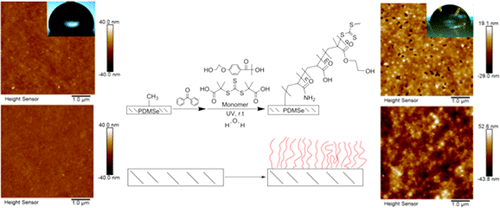当前位置:
X-MOL 学术
›
Macromolecules
›
论文详情
Our official English website, www.x-mol.net, welcomes your feedback! (Note: you will need to create a separate account there.)
Engineering the Surface Properties of Poly(dimethylsiloxane) Utilizing Aqueous RAFT Photografting of Acrylate/Methacrylate Monomers
Macromolecules ( IF 5.5 ) Pub Date : 2018-01-08 00:00:00 , DOI: 10.1021/acs.macromol.7b02575 Cary A. Kuliasha 1 , Rebecca L. Fedderwitz 1 , Patricia R. Calvo 1 , Brent S. Sumerlin 1 , Anthony B. Brennan 1
Macromolecules ( IF 5.5 ) Pub Date : 2018-01-08 00:00:00 , DOI: 10.1021/acs.macromol.7b02575 Cary A. Kuliasha 1 , Rebecca L. Fedderwitz 1 , Patricia R. Calvo 1 , Brent S. Sumerlin 1 , Anthony B. Brennan 1
Affiliation

|
Polymeric surface grafting offers a tunable way to control the interfacial interactions between a material’s surface and its environment. The ability to tailor the surface properties of poly(dimethylsiloxane) elastomer (PDMSe) substrates with functional chemistry, wettability, and roughness can enhance the fields of biofouling, microfluidics, and medical implants. We developed a reversible addition–fragmentation chain transfer (RAFT) polymerization technique to synthesize a host of copolymers composed of acrylamide, acrylic acid, hydroxyethyl methacrylate, and (3-acrylamidopropyl)trimethylammonium chloride with targetable molecular weight from ∼5 to 80 kg/mol and low dispersity of Đ ≤ 1.13. This RAFT strategy was used in conjunction with photografting to chemically engineer the surface of PDMSe with hydrophilic, hydrophobic, and anionic groups. Varying grafting time and copolymer composition allowed for targetable molecular weight, chemical functionality, and water contact angles ranging from 112° to 14°. These new material surfaces will be evaluated for their antifouling and fouling release potential.
中文翻译:

利用丙烯酸酯/甲基丙烯酸酯单体的RAFT光接枝工程化聚二甲基硅氧烷的表面性能
聚合物表面接枝提供了一种可调节的方法来控制材料表面与其环境之间的界面相互作用。通过功能化学,润湿性和粗糙度来定制聚二甲基硅氧烷弹性体(PDMSe)基材的表面性能的能力可以增强生物污垢,微流控和医疗植入物的领域。我们开发了一种可逆的加成-断裂链转移(RAFT)聚合技术,以合成目标丙烯酰胺,丙烯酸,甲基丙烯酸羟乙酯和(3-丙烯酰胺基丙基)三甲基氯化铵组成的一系列共聚物,其目标分子量从约5至80 kg / mol Đ的分散度低≤1.13。该RAFT策略与光接枝结合使用,对具有亲水,疏水和阴离子基团的PDMSe表面进行化学工程处理。接枝时间和共聚物组成的变化可实现目标分子量,化学官能度和112°至14°的水接触角。将评估这些新材料表面的防污和防污释放潜力。
更新日期:2018-01-08
中文翻译:

利用丙烯酸酯/甲基丙烯酸酯单体的RAFT光接枝工程化聚二甲基硅氧烷的表面性能
聚合物表面接枝提供了一种可调节的方法来控制材料表面与其环境之间的界面相互作用。通过功能化学,润湿性和粗糙度来定制聚二甲基硅氧烷弹性体(PDMSe)基材的表面性能的能力可以增强生物污垢,微流控和医疗植入物的领域。我们开发了一种可逆的加成-断裂链转移(RAFT)聚合技术,以合成目标丙烯酰胺,丙烯酸,甲基丙烯酸羟乙酯和(3-丙烯酰胺基丙基)三甲基氯化铵组成的一系列共聚物,其目标分子量从约5至80 kg / mol Đ的分散度低≤1.13。该RAFT策略与光接枝结合使用,对具有亲水,疏水和阴离子基团的PDMSe表面进行化学工程处理。接枝时间和共聚物组成的变化可实现目标分子量,化学官能度和112°至14°的水接触角。将评估这些新材料表面的防污和防污释放潜力。


























 京公网安备 11010802027423号
京公网安备 11010802027423号